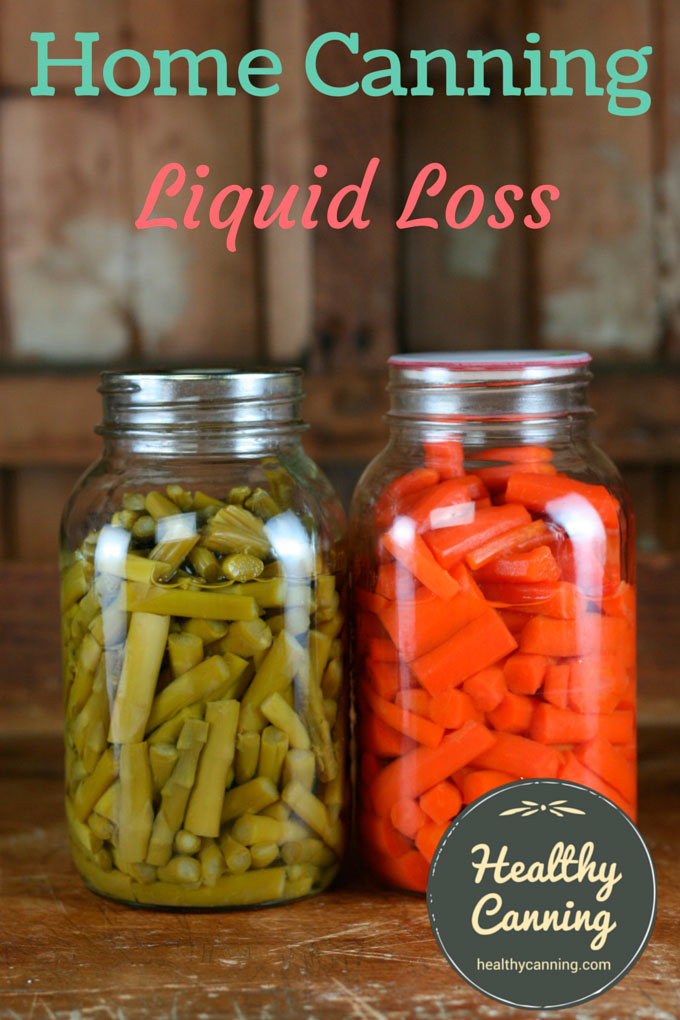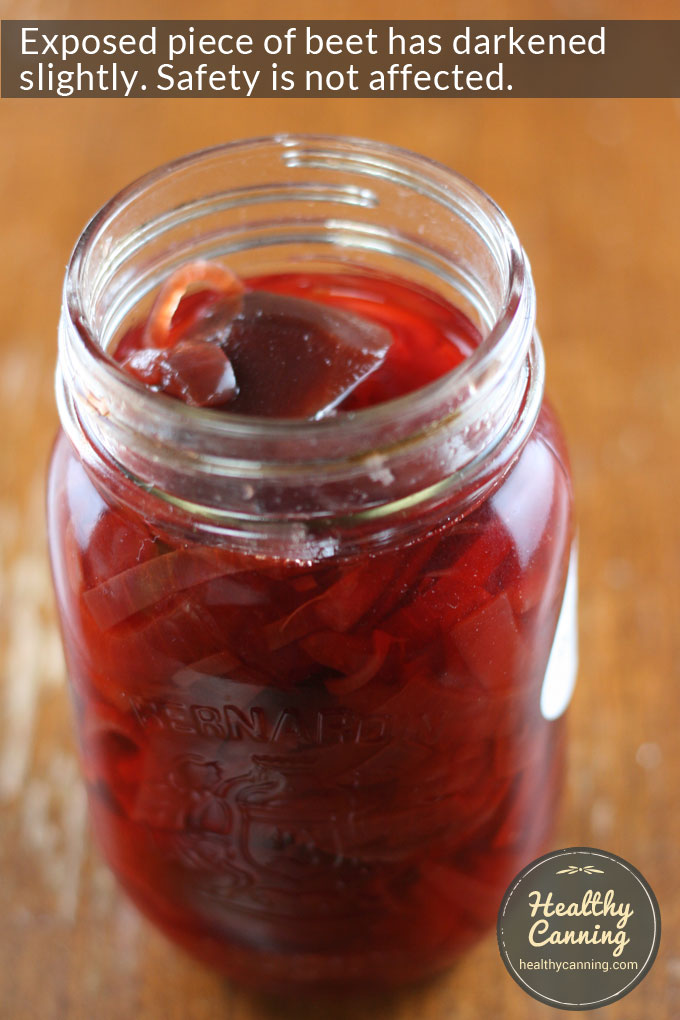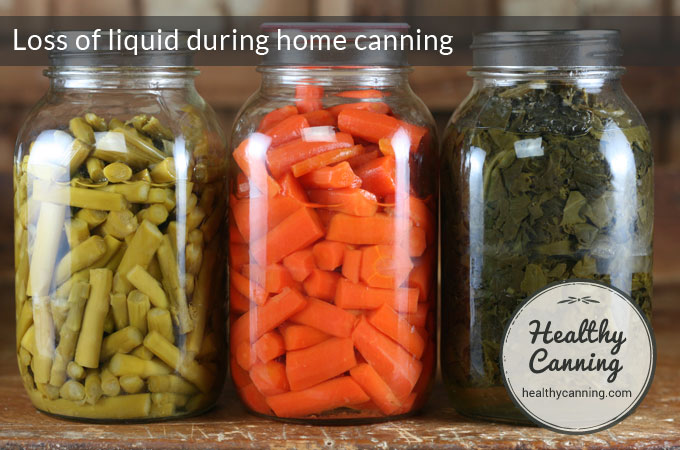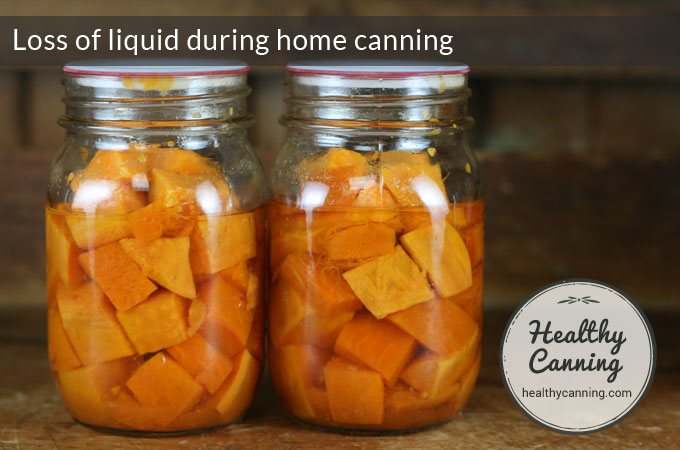Jars will often lose or appear to lose some liquid during processing, especially during pressure canning. It seems to rarely happen during water-bathing.
This is not a safety concern, but it will shorten the shelf-life of those canned goods.
The produce is still safe
Here the the basic guidelines from the National Center for Home Food Preservation about how to react to this:
If liquid has been lost from jars, but the jars have sealed, do not reopen them to replace it. Use those jars first or food may become discolored. If more than half of the liquid in the jars has been lost, the food may not be adequately processed. In this situation, break the seal on the lid, refrigerate the jar and use it within 2 to 3 days.” [1] National Center for Home Food Preservation Self-Study course. Module 2. “General Canning: Post-processing Checks”
Loss of liquid from a jar of home canned goods means excess headspace, and consequently, in more pronounced cases, it can prevent a seal from occurring. However, jars usually do seal even if your headspace has increased owing to liquid loss.
Loss of liquid will shorten the quality lifespan of a jar a bit, because the food above the water line may discolour a bit over time. But, it’s not the end of the world, just annoying and embarrassing, if you had wanted to show the jars off. It will make the jar less photogenic, and shorten the cosmetic life of the food that is above the liquid line, but otherwise you are fine safety-wise. The safety of the food that discoloured is not impacted.
Severe liquid loss — when the water level has gone to less than half — is a potential safety problem, however. In that case, the jar may have had density issues, with not enough water to allow the heat to circulate evenly. So break the seal of the jar (if it sealed), and refrigerate and use soon (or drain, freeze, if appropriate.)
The NCHFP further assures us,
If all other processing variables are accurate, less than half of the liquid is lost from the jar and the jar seals, then the product is still safe for shelf storage. Product that is not covered by the liquid will darken. Use these jars first. If more than half of the liquid is lost, heat penetration may not be adequate. When these jars are removed from the canner and cooled, the seal should be broken, and the jars refrigerated for use within 2 to 3 days.” [2] National Center for Home Food Preservation Self Study Course. Module 4. Canning Low Acid Foods: Problems in Pressure Processing. Accessed March 2015.
Whatever you do, don’t open the jars to add water back in, then put the lids back on and the jars on the shelf: “If liquid boiled out of jars during processing, do not open jars to add more liquid.” [3] Fraser, Angela. Associate Professor/Food Safety Education Specialist. How Canning Preserves Food. Clemson University, Clemson, SC. Accessed March 2015 http://www.foodsafetysite.com/consumers/resources/canning.html. . [/ref]
Ball says, “You may notice a slight decrease in the food and / or liquid levels. This happens as food shrinks from heat processing. It may also result from a siphoning of the liquid during processing. Should you notice a change, do not open the jars to add product or liquid. The sealed jars should be stored as is.” [4] Ball Blue Book Guide to Preserving. Daleville, Indiana: Hearthmark LLC. Edition 36. 2013. Page 12.
What causes loss of liquid during home canning?
There are several possible causes, experts say:
- Siphoning — liquid in the jar being forced out or drawn out;
- Improper cool-down procedure;
- Hidden air in the jar making itself known and rising to the top of the jar;
- Lid related;
- Water-bath canning issues.
#1 applies to pressure canning; #2 to #4 can apply to either pressure or water bath canning; #5 applies to water-bath canning.
1. Siphoning
Siphoning technically means liquid being drawn out, but in home canning circles the term seems to be often used as a catchphrase to include liquid being pushed out as well.
If you overfill jars and leave insufficient headspace, you can end up with excess headspace because food will expand during processing (even if it shrinks back afterwards) and if there is insufficient room, while doing so it will push water out to make room for its expansion.
Siphoning can also be caused by fluctuating pressure.
Fluctuating Pressure
Fluctuating pressure can cause liquid loss.
The National Center for Home Food Preservation teaches,”Changes in pressure during processing may result in a loss of liquid from jars.” [5] National Center for Home Food Preservation Self Study Course. Module 4. Canning Low Acid Foods: Problems in Pressure Processing. Accessed March 2015.
Patti Griffith from the University of Wyoming Cooperative Extension writes,
When pressure is released too frequently or constantly, liquid is pulled from the jars inside. This is a common problem in jars canned in a weighted-gauge canner. If the jars stay sealed after they are cooled, the product inside is safe to use even though the liquid is down. Pulled liquid may keep some jars from sealing because the residue on the jar rim will prevent a complete seal.” [6] Griffith, Patti. Making Canning Work for You. University of Wyoming Cooperative Extension Service. MP-119-12. Accessed March 2015 at https://www.wyomingextension.org/agpubs/pubs/MP119_12.pdf
Note that she warns specifically against having the pressure so high on a weighted-gauge canner that the device is always struggling to release the excess pressure. Presto, a manufacturer of pressure canners, also says liquid loss can be owing to this: “Pressure regulator on the weighted gauge canner rocked vigorously during processing. Always maintain a slow, steady rocking motion.” [7]Presto Frequently Asked Questions. Accessed March 2015 at https://www.gopresto.com/recipes/canning/faq.php#12
Lowering the pressure too quickly after processing can cause siphoning. Wait until the pressure is at absolute 0 before removing the counter-weight or petcock. Presto says that even “bumping the pressure regulator before pressure has completely dropped” can cause siphoning. [8] Presto Frequently Asked Questions. Accessed March 2015 at https://www.gopresto.com/recipes/canning/faq.php#12
2. Improper cool-down procedure
Cooling the jars too quickly after processing can cause liquid loss.
After a pressure canner has returned to absolutely zero, remove the weight and let the machine rest as is for 5 to 10 minutes (opinion varies whether it should be 5 or 10 minutes.) Then after removing lid, let the jars rest undisturbed for a final 10 minutes before removing.
Not allowing jars a bit of time like this to re-acclimate to the real world can cause liquid to escape from the jars.
For water bathing, after the processing time is up, turn off the heat, remove the cover and let the jars rest as they are in the water for 5 minutes before removing.
3. Hidden air in the jar making itself known and rising to the top of the jar
Raw food has a lot of air in it. The volume of food you have put in a jar before processing might actually only be ¾ food and ¼ air trapped inside the food. During processing, this air will escape from the food and rise to the top of the jar.
The Presto manual notes the following: “Failure to precook food before packing in jars thus allowing shrinkage to occur in the jar. It is especially important to preheat fruit.” [9] https://www.gopresto.com/recipes/canning/faq.php#12. Note that the Presto people don’t like cold packs, and in their manual don’t even give you the cold-pack option for fruit as the NCHFP does; Presto gives only hot pack choice. Note as well that the Ball Blue Book [10]Ball Blue Book. Muncie, Indiana: Healthmark LLC / Jarden Home Brands. Edition 37. 2014. Page 12. and the Bernardin Guide [11]Bernardin Guide to Home Preserving. Toronto, Canada: Bernardin Ltd. 2013. Page 36 emphasize that the hot pack is always preferred, too.
Starchy foods such as beans can absorb water, making it seem as though it has disappeared. This is less of a problem if you use hot pack for these types of food, which is the generally the recommended pack type, anyway.
Here’s a video discussion from a home canner about pack-type effect on apparent liquid loss:
Air is also often trapped between pieces of food as you pack the jars, and during processing it too will rise to the surface. Debubbling helps with this. [12] What can cause loss of liquid from jars during processing? In: Fresh Preserving & Canning Questions. Ball Corporation. Accessed March 2015 at https://www.freshpreserving.com/tools/faqs
- Re-using previously used canning lids;
- Not wiping the jar rims before putting the lids on (trapped particles of food on the rim could raise the lid, allowing water to escape);
- Canning ring bands were too loose, allowing too much venting : “If rings are too loose, liquid may escape from jars during processing, and seals may fail.” [13] United States Department of Agriculture (USDA). Complete guide to home canning. Agriculture information bulletin No. 539. 2015. Page 1-16
5. Water-bath canning issues
In water-bath canning, liquid loss can occur if the jar lids are not covered with sufficient water during processing. Fruits packed in syrup or water are especially prone to this.
Miscellaneous
And, it seems, there is one more reason not listed in the above reasons from the experts, which is: phase of the moon! It can sometimes just occur when you will swear you have done everything right, forwards and backwards.
As long as the jar seals and you haven’t lost more than half the liquid in the jar, you are good to go.
Further Reading
Elizabeth L. Andress. Ph.D. and Judy A. Harrison, Ph.D. General Canning Information: Causes and Possible Solutions for Problems with Canned Foods. National Center for Home Food Preservation.
Presto Frequently Asked Questions.
References





Gayle Schmidt
I used my pressure canner to do green and yellow beans in pint size jars and a lot of liquid escaped are they still safe to eat? or what should I do to correct I am new to pressure canning so any help would be great.
Vern
I pressured canned chicken breasts, raw packed, added liquid left right amount of head space. Some jars we’re fine liquid was normal but a couple jars we’re less liquid, probably still had above half of the jar left. Think they are ok?
Audrey
Hello – thank you for the information. It is discouraging to pull out the jars only to find a less than perfect looking product.
I just did several quarts of sweet potatoes and every jar has siphoning. I followed the instructions to the letter. I have been wracking my brain for a cause and it could be one of several listed above. Cool down too quickly is a likely culprit. Also very open concept first floor and a nearby back door opened several times allowing crisp air to enter.
Could a problem with the gauge lead to siphoning? I have not had mine checked since pre-C, so it might be off a bit.
Thank you again for your expertise and thanks to all who asked questions and shared experiences.
Happy Canning!
Thresa
Thank you so much for this article it was extremely helpful. This was only my 2nd time canning and so I was a little discouraged by the loss of the liquid. This encouraged me just to be patient with the cooling down process. All of my jars did seal.
Vern
I pressured canned chicken breasts, raw packed, added liquid left right amount of head space. Some jars we’re fine liquid was normal but a couple jars we’re less liquid, probably still had above half of the jar left. Think they are ok?
Elsa Nathe
Hi, I’m using an instant pot max , the one you can use for canning .I did beets and some liquid leaked from the jars into the canner .Think I followed the instructions.Any advice would be helpful 😊
Elsa
Healthy Canning
The advice is NOT to believe the makers of Instant Pot that they are safe for home canning at all. See: https://nchfp.uga.edu/publications/nchfp/factsheets/electric_cookers.html
Mina LaFortune
I’ve just processed 18 pint jars of carrot fennel soup and ALL have lost liquid. This is a rare case for me. At times, perhaps 1 or 2 if any. They lost roughly 1/2″ on average. I’m tempted to empty the jars and add more liquid to the batch. Bring to a boil and try again. This would be safe to do right? Since it’s soup I’m not too concerned about overcooking.
Healthy Canning
We’ve recanned that soup when some failed to seal the first time– on that occasion, the quality did suffer the second time through the canner. It darkened a great deal and came out of the canner with an unsightly foam on top – no idea why. Your call — it’s a quality question.
Mina
Thanks for the heads-up. I went ahead and emptied the jars, added some extra stock and reprocessed. Not sure what happened to the first batch but this time all the jars sealed beautifully and there was no loss in head space! There wasn’t any ‘foam’ that you mentioned either. The only thing I can think of that was different was my hubby LOL. He helped with the first batch haha!
A
This page was really helpful. I appreciate that you cited multiple sources and the pictures were spot on.
diane weiss
i discovered that my pressure canner syphons a lot of the time. i have noted what may be solutions to my problem, at least some of the time. also, perhaps the canner had more water than the 1-3 inches recommended as it is usually the bottom layer that syphons? my question is can i reuse/consume the liquid/juice that was siphoned and is collected in the canner? my canner is aluminum and i question if the metal leaches into the liquid, thus rendering it dangerous to consume. i have had this happen on numerous occasions with numerous product (pumpkin slices, beets, carrots) this summer and it pains me to toss what can be reused, even if only in soup. could someone answer me?
Healthy Canning
You wouldn’t want to use that water if because (a) it has vinegar in it that you’ve put in to prevent the jars going cloudy and (b) because it has been in contact with the canning rings. Consider instead tackling the causes of the siphoning. Bring it up to pressure slowly. And down from pressure slowly. If you find certain things continue to siphon on you, consider giving them an extra 1/4 inch headspace maybe. Best to try to keep the water in the jars to cover the food during storage.
Maria Ligon
I have this problem with hot peppers in brine. This year I got a steam canner, same problem loss of water. My question is can this hot peppers be re processed??? My husband will not eat them if the water is low which is usually about 1/4 or 1/2 from the top of the jar.
Thank you
Healthy Canning
So, you have pickled hot peppers in vinegar, correct? And what exactly is the headspace that you ended up with?
Miss Conserves
I have been teaching people how to pressure can for 18 months now, and I go to people’s house and in different schools, community centers and all kinds of places. I have notice that, depending on the size of room, different ventilations or air circulation, the cooling process varies a lot. I always use the same canner and the same 500ml jar of carrots in water, but the cooling of the canner will be much faster in larger rooms or open concept kitchens, witch tends to make liquid losses more important and more frequent.
So watch out those who have large open concept kitchens and houses!
Healthy Canning
Excellent observation, madame!
Graham
Ah, I thought maybe I had somehow boiled the water out, but now that I think about it, I was running the pressure canner outside on a big gas burner and then when it reached it’s cooking time I just went out and turned it off because it was late at night, thinking that it would cool down and I could empty it in the morning. As it is getting cold here as we go into winter it would have been about 3C during the night and so would have cooled down fairly rapidly. The interesting thing that I noted was that the jars on the top layer lost the most liquid. They were sitting above the water in the bottom of the canner. That water would have cooled slower than the air and therefore allowed the bottom layer of jars to cool slower and so they ended up loosing much less liquid.
Darlene
I cold packed my cherries and a couple of the jars the fruit is not coved. Are they ok?
Healthy Canning
The term is “raw pack.” Yes, provided you followed all the directions here ( https://nchfp.uga.edu/how/can_02/cherry_whole.html ), they should be fine, assuming you mean that just an inch or two of the food in the jars is exposed to air. Just put those jars at the front of the shelf, so they will get used up first.
florence coutts
Hi,
I understand everything written above but looking at my pressure canned garbanzo beans with what seems like little or no liquid in the jar, I am unsure to throw out or not. I did pre-cook them the precious day and brought them up to boiling point before canning. Do I need to maintain the goiling point while oacking them or anything?
Healthy Canning
If you followed the USDA / Ball / Bernardin directions exactly, then there’s no need to worry. In fact, just yesterday I canned a batch of dried beans that were probably over a year old, and I would not say there is a lot of visible water in the jar. The beans do absorb a whole lot more water during canning, especially if they are older and thus very dry beans — which is why they want the beans pre-soaked and par-boiled first to cover all eventualities. So they will be fine. (No you don’t need to keep them boiling in the pot while packing them in jars.)
Susie
I’m new to canning and have followed the instructions to the letter but still get some siphoning. I warmed the jars, made sure I used vinegar to clean the jars etc. I keep the pressure exactly on 11 and then switch off the pressure cooker and leave it for ages before opening. wondered if I’m putting too much water in the canner asit says three inches but it does come quite high up the jars as I tend to use 500 ml or pint jars. Any ideas where I’m going wrong. It’s not too much out of the jars but still I’m wondering why?